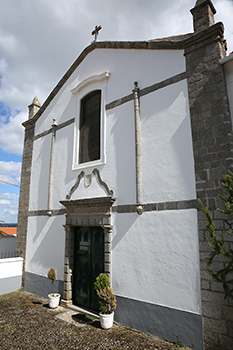 |
The history of this convent is very little known and is sometimes surrounded by some contradictions, and that require more accurate investigation, therefore we maintain Espanca’s version.
According to the author, a Beaterio (a community of pious men and women from a locality) was established in 1528 by the couple Isabel Cardoso and Manuel Fernandes Rodovalho - members of the local nobility of Viana - for elderly women and the poor. It would operate in the vicinity of Poço Novo (located at the intersection of the current street Miguel Bombarda with the street António Isidoro de Sousa), in houses belonging to the couple. The foundress herself went to this gathering in 1544, after widowhood. Later, between 1578 and 1580, the secluded women were transferred to the Mosteiro do Bom Jesus (monastery of Bom Jesus), founded between 1548 and 1553 in the same area of the village, but which had already been transferred to a new building on the outskirts in 1560. With the exit of the secluded women, around 1580, the religious house then received the friars of the Third Order Regular of St. Francis, from which comes its most common name. However, the small size of the building determined its expansion with alms from private individuals, especially with the sponsorship of D. Luísa Cabral de Quadros, who received the patronage of the main chapel in 1590.
It was closed in 1834 – time when it only housed 7 friars - following the law of extinction of the religious orders, being sold by public auction, after which it was left abandoned for some time.
In 1859, under the auspices of the physician António José de Sousa and his wife, D. Maria José Guimarães de Sousa, the temporary shelter for underprivileged children was founded in the building to receive orphaned children, and a nursery to collect and feed poor children, sons and daughters of rural workers, from one year and a half to four years of age, during the periods when their mothers worked. According to Sousa, it was one of the first nurseries created in Portugal, under the regency of the hospitable sisters of Trinas de Mocambo, from Lisbon. In 1866 the merits of the institution were officially recognized, receiving the patronymic of Nossa Senhora da Conceição (Our Lady of the Conception), Portugal’s patroness, according to information of Túlio Espanca. In the same year, the foundation of the Charity Association, headed by D. Maria José de Sousa and later by her daughter, D. Francisca Deodata de Sousa, consolidated the services’ performance.
In 1960 the building, namely the church, undergoing remodelling, suffered a complete architectural disfigurement, having the four altars that the church had in gilded woodcarving and marble, baroque and rococo, from the 17th and 18th centuries, and the steeple that existed on the North face of the temple been removed. The church reopening to the cult took place in 1967.
The body of the church nave might be from the 17th century, in rectangular plan with a vault of half barrel. The portico shutters are from the 18th century and over it there is a window from the same period.
A fairly peculiar sacred relic existed in this convent until the 19th century. According to tradition, it was the skull of one of the Magi. This relic was offered by the Pope to King D. Sebastião, who will have donated it to his nurse, D. Inês Pimentel, whose heir (Manuel Mendes Pimentel) donated it to the convent in the 17th century, in order to be buried, in exchange, in the coenobitic church, in the chapel of S. Bento.
1 - A community of pious men and women from a locality
REFERENCES
ARQUIVO NACIONAL/TORRE DO TOMBO, Memórias Paroquiais, Vol. 39, nº 150, pp. 891-910. Disponível on-line em http://portugal1758.di.uevora.pt/index.php/lista-memorias/78-viana-do-alentejo/3420-viana-do-alentejo-viana-do-alentejo
CARDOSO, George - Agiologio lusitano dos sanctos, e varoens lllustres em virtude do Reino de Portugal, e suas conquistas ....,Lisboa, Officina Craesbeekiana, 1652-1744.
ESPANCA, Túlio, Inventário Artístico de Portugal: Distrito de Évora: Concelhos de Alandroal, Borba, Mourão, Portel, Redondo, Reguengos de Monsaraz, Viana do Alentejo e Vila Viçosa, Lisboa, Academia Nacional de Belas-Artes, 1978,Tomo IX, Vol. 1.
FARRICA, Fátima, “A cabeça de um dos Reis Magos no convento de São Francisco de Viana do Alentejo no século XVI”, apresentação na Tertúlia sobre Arquivos e História “Um documento antigo, uma história para contar”, 9 de Junho de 2014.
LEAL, Augusto Soares de Azevedo Barbosa de Pinho, Portugal antigo e moderno: diccionario geographico, estatistico, chorographico, heraldico, archeologico, historico, biographico e etymologico de todas as cidades, villas e freguezias de Portugal e de grande numero de aldeias, Lisboa, Livr. Ed. de Mattos Moreira & Companhia, 1882, Vol. 10.
SOUSA, João Manuel Santana de, História da Primeira Adega Social Portuguesa, Viana do Alentejo, Câmara Municipal, 1993.
http://www.monumentos.pt

 Abrir Lista
Abrir Lista MUNICÍPIO DE VIANA DO ALENTEJO
MUNICÍPIO DE VIANA DO ALENTEJO